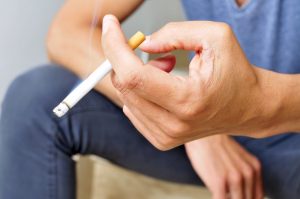 Obstructive sleep apnea (OSA) is a condition that primarily affects adults; however, children can suffer from the breathing disorder, too. Although only 4% of children have OSA, new research has found a connection between secondhand smoke and sleep apnea. If you smoke, you may be placing your child at risk of the condition, which causes frequent pauses in breathing throughout the night. Here’s why you may want to kick the habit to keep your child healthy.
Obstructive sleep apnea (OSA) is a condition that primarily affects adults; however, children can suffer from the breathing disorder, too. Although only 4% of children have OSA, new research has found a connection between secondhand smoke and sleep apnea. If you smoke, you may be placing your child at risk of the condition, which causes frequent pauses in breathing throughout the night. Here’s why you may want to kick the habit to keep your child healthy.
Secondhand Smoke and Childhood Sleep Apnea
Research has found that 7% to 11% of children have a nighttime breathing disorder; however, up to 90% of cases aren’t diagnosed. A 2014 study found that 1 in 5 children have obstructive sleep apnea. As a result, it’s important to be vigilant for any signs of OSA.
Most often, sleep apnea is seen in children with large tonsils and adenoids, abnormalities with the airway, or obesity. However, according to the International Journal of Pediatric Otorhinolaryngology, secondhand smoke can increase the risk of OSA in children.
The study involved nearly 4,000 children. 53% of participants were exposed to secondhand smoke. Researchers found children exposed to it were 1.48% more likely to have sleep apnea than those not exposed to secondhand smoke. Although more research is needed, it is evident that frequent exposure to tobacco smoke can be a risk factor for sleep apnea in children.
Symptoms of Sleep Apnea in Children
Pediatric obstructive sleep apnea can cause a variety of symptoms, which can vary from those present in adults. Whether your child is exposed to secondhand smoke or not, it is best to watch for any signs of OSA, which can include:
- Chronic snoring
- Pauses in breathing while sleeping
- Restless sleep
- Coughing, choking, or snorting
- Mouth breathing
- Bedwetting
- Sleep terrors
- Nighttime sweating
Symptoms of the condition can also appear throughout the day, which can manifest as:
- Poor school performance
- Difficulty paying attention
- Learning problems
- Behavioral problems
- Difficulty gaining weight
- Hyperactivity
Without any treatment, serious complications can occur, including failure to grow, cardiovascular problems, and even death in extreme cases.
Diagnosing Sleep Apnea in Children
If your child’s pediatrician suspects sleep apnea, they will recommend sleep testing. Their breathing patterns, vitals, and brain wave activity will be monitored while they are sleeping. The information gathered will be analyzed to determine if any treatment is necessary.
There aren’t any universal guidelines for treating OSA in children. Some children will outgrow the condition, while others may require treatment, like diet changes, tonsillectomy, or sleep apnea therapy.
If you’re a parent who smokes, one of the best things you can do for yourself and your child is quit. You and your child can sleep soundly and breathe easier.
About Dr. Stephanie Gorczyca
Dr. Gorczyca earned her dental degree from the UCLA School of Dentistry before continuing her education in advanced services, like sleep apnea therapy. She strives to improve her patients’ quality of life using personalized solutions. If you think your child might need sleep apnea therapy, contact our office today to request a consultation.
